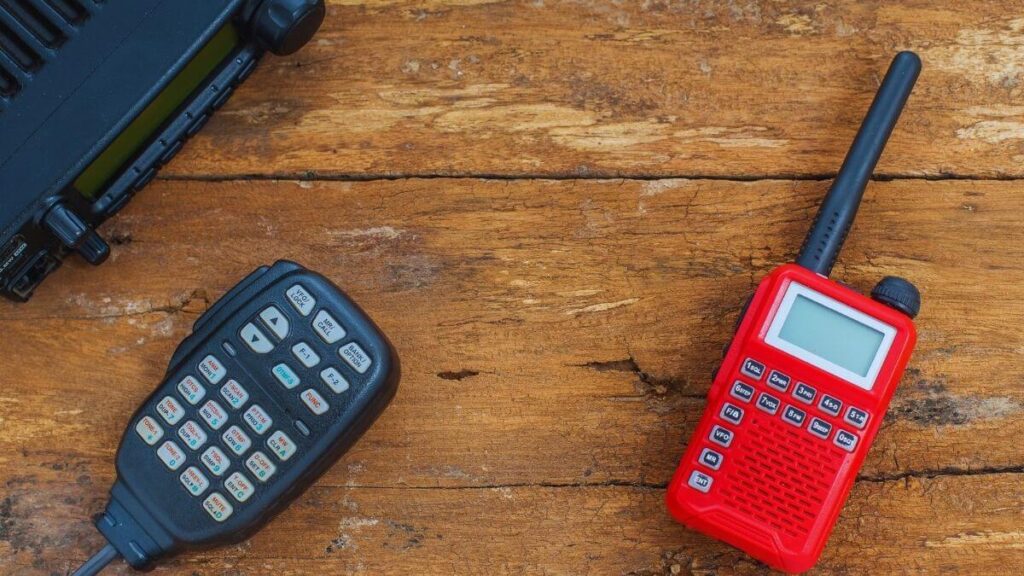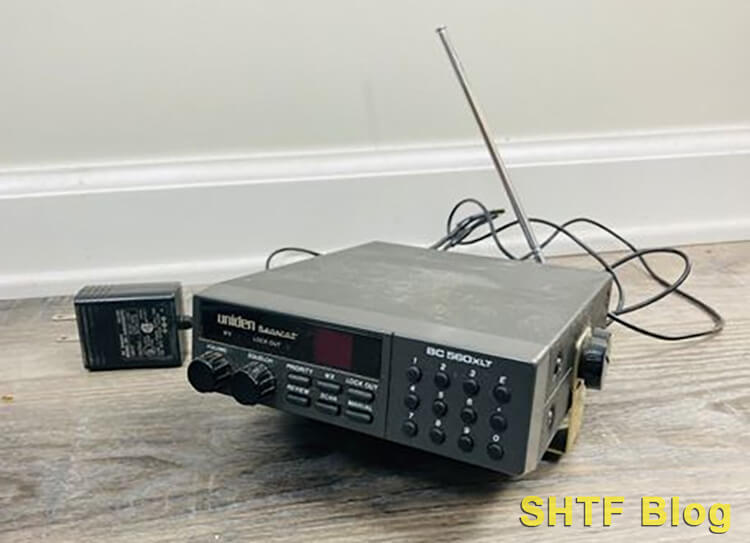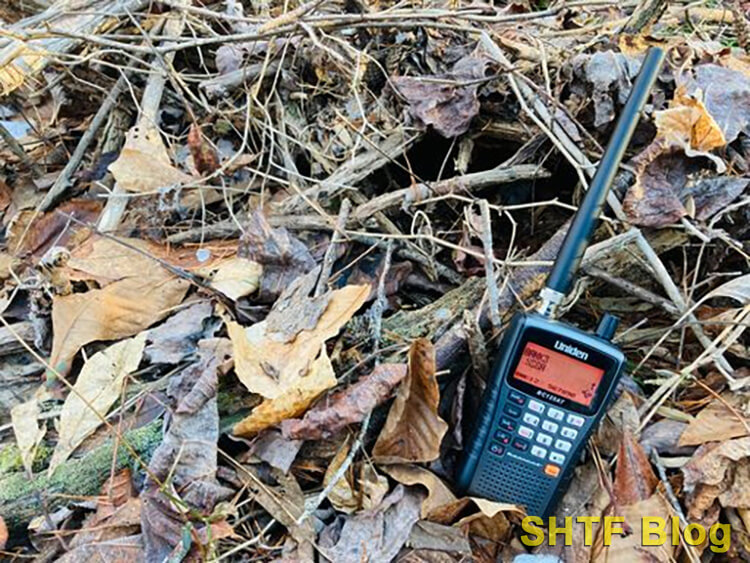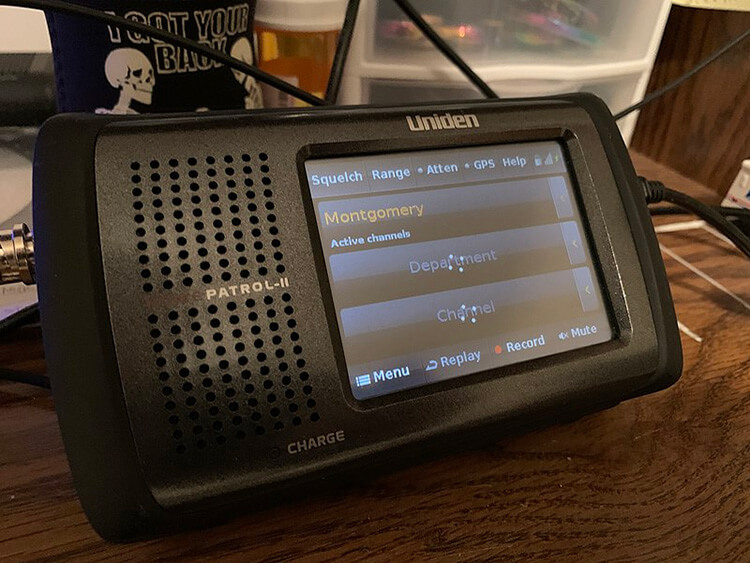
So you’ve got a little bit of money set aside and you really want to focus in on your post-disaster comms. You don’t feel like you need another transceiver at the moment, but there is one piece of equipment that’s missing from your ham shack: a scanner.
The problem though is this: you know that there are two types of scanners out there – analog and digital – and you can’t decide which one you should get. What do you do? Should you buy an analog or digital scanner?
Why Buy an Analog or Digital Scanner in the First Place?
To start with, if you’ve ever used a transceiver such as a Baofeng UV-5R, you know that the scanning speed is abysmally slow. Time can very easily be life, particularly within a disaster setting – and this isn’t a luxury that can be afford to be wasted.
Consider if you know there’s a call for help somewhere out there on the 2m band after a disaster. Your elderly dad lives all the way on the other side of town and you’d purchased a ham radio for him as part of a disaster kit. Should all go to crap, at least dad would be able to get in contact with you.
But you forgot to establish a comms window. You never set up a designated set of frequencies to talk on, nor did you set up a designated time to talk. You’ve a pretty good idea that your dad is on the radio trying to reach you (let’s say there’s been a foreign troop invasion and you live in Alaska), you just don’t know which frequency.
You can try to scan all of the 2m band with your little Baofeng radio, but by the time you reach 146.500, your dad may very well have finished his broadcast for help.
This is where a scanner comes in to play. They’re very, very fast. If you’ve already programmed in a set of frequencies into your memory, they’re lightning fast as well. This speed with scanning through a part of the radio spectrum can have a number of uses, aside from the one listed above.
What if a Hurricane Katrina type event takes place, you’re trapped in your attic due to rising flood waters, and are searching for where the radio traffic is? A scanner can help you find it quickly.
What if you’re monitoring your local police frequencies to keep a close eye on the nearby “burn the city” riot? A scanner can help you to ensure you don’t miss anything important.
What if you’re trying to find actionable intel about a roving band of looters post-SHTF which is known to use radios for group comms? A scanner will help you to better determine which frequencies the looters are operating off of.
In short, a scanner is a fantastic piece of gear which can both provide you with a lot of information in a hurry and make your job of finding that information much easier.
The Advantages of an Analog Scanner
There is one predominant advantage to an analog scanner and that is the price. For all of $100, one can purchase a scanner which will allow them to start listening to a lot of traffic that’s taking place over the radio spectrum.

Think about this: how many people do you know that are involved with ham radio? If you’re well inserted into the prepper scene, probably more than the average joe, but still, the numbers are slim, right? While ham numbers have most certainly skyrocketed the past two years, we’re still a very small minority within the US.
That being the case, think about a post-collapse situation. World War 3, Civil War 2.0, or some other violence has taken place. Perhaps you have the motorcycle gangs of Joe Nobody’s series. Maybe it’s groups of organized looters roving about as in Rawle’s Patriots.
Whatever you have, do you think that those people are likely to be communicating with digital radios or with analog? Before you answer that question, consider which you are more likely to see in a Walmart, Bass Pro Shops, or Gander Mountain: analog FRS/GMRS walkie-talkies or digital ham radios? Without a doubt, what you’ll see are FRS/GMRS walkie-talkies. So that being the case, what do you think those gangs and looters are likely to use?
The answer? Analog.
And for $100, you can get in the game of listening.
The Disadvantages of an Analog Scanner
While the price of analog scanners is very cost-friendly, there’s a reason for that: analog technology has been around forever. And as time goes on, technology is improved and/or replaced. The same has happened within the field of radio. Digital modes were created, and they gradually spread throughout the radio world. The problem with using an analog scanner is that these digital modes can be pervasive, particularly within the world of the uniform.
If you’re mainly wanting to listen in on police frequencies or unencrypted military talk (yes, it does exist), you’ll be wasting your money on an analog scanner. The reason for this is that both of these groupings of people have almost fully made the transition to digital mode radio.
Sure, it depends on where you live, but for the most part, this is the direction that police departments are headed. A county which doesn’t use digital mode radios for their police is often considered as backwards or behind-the-times within the police community.

You can check if your specific locale uses digital or analog for their police department by looking at RadioReference.com. If you don’t, and you buy an analog scanner, you’re not going to be able to listen in on any of the talk you were hoping to pick up at all. Analog cannot pickup digital mode.
The Advantages of a Digital Scanner
I would argue that the chief advantage of a digital scanner is that you get more bang for your buck. With digital scanners I can listen to both digital and analog signals.
Police frequencies? Check.
Seasoned hams? Check.
EMS teams? Check.
It’s all there. A digital scanner allows you to hear it all.
If you’re looking for a one-and-done purchase, you want to listen to as much of the radio spectrum as possible, and you’ve truly got an interest int listening to anything attached to the government’s payroll, then you’re going to want to invest in a digital scanner right off the bat.
The Disadvantages of a Digital Scanner
There is one disadvantage, I think, to digital scanners.
It’s the price. These things are expensive. Unless you have $400 to drop, you’re not even going to be able to start to get in the game with digital scanners. While I do think that there are good preps to save for, and that this is a superior piece of equipment to analog, I do have a few drawbacks to this price.
For starters, it’s the preps you have which come in handy in a disaster, not the prep still on the store shelves. If The Event kicks off and you have $300 in your hand but no scanner, well, you don’t have a scanner. Definitely prep according to your means as well. $400 is simply too cost prohibitive for a lot of people.
What are Some Good Analog Scanners?
Uniden is perhaps the largest player in the world of scanners, so you’ll see their name pop up frequently in any discussion of such. Here are a few good analog scanners to consider:
Uniden Bearcat BC125AT
- LISTEN IN AND STAY INFORMED, this sophisticated scanner has 500 alpha-tagged channels in a convenient compact design with loads of features. Close Call RF capture technology instantly tunes to signals from nearby transmitters and the Do Not Disturb Mode prevents Close Call checks during a transmission.
- LISTEN TO OVER 40,000 FREQUENCIES, you can listen to both civilian and military bands, including Non-Digital Police, Ambulance, Fire, Weather, Marine, Aircraft, Railroad, Civil Air, Amateur radio services, and Racing events.
- SEARCH MORE EFFICIENTLY with 500 Alpha-Tagged Channels finding the channel you want to listen to is easy, with 500 channels divided into 10 storage banks. Organize your channels by department, location, area of interest, or any other way you prefer. Alpha Tagging lets you assign names to your channels, so you can keep track of who you are listening to.
- LIGHTWIEGHT PORTABLE DESIGN, take this Bearcat handheld radio scanner with you on the road, or on outings. It packs plenty of features, the orange backlight display is easy to read, even in low light conditions.
- GET STARTED LISTENING RIGHT AWAY with convenient Pre-sets for the most popular searches. Frequencies are preset in ten separate Non -Digital Police/Fire/Emergency, Ham, Marine, Railroad, Civil Air, Military Air, CB Radio, FRS/GMRS/MURS, and Racing search bands. This makes it easy to find channels that interest you.
A small, handheld unit, this is a good model to consider if you’re looking for something to strap onto your kit as you head out into the woods. As of this writing, it only costs $115, and you get a pretty standard selection of features for your money.
Close call is present, you can store 500 channels organized in 10 different memory banks (very convenient. This allows you to separate your police frequencies, FRS frequencies, EMS frequencies, etc.), and runs off of two AA batteries.
Uniden Bearcat SR30C
- LISTEN IN AND STAY INFORMED! The Uniden Bearcat SR30C is a very affordable 500 channel hand-held scanner with loads of features in a convenient compact design.
- LISTEN TO OVER 32,000 FREQUENCIES: Get started listening right away with convenient pre-sets for the most popular searches. Frequencies are preset in ten service banks, Non-Digital Police/Fire/Emergency, NOAA Weather reports, Marine, Racing, Civil Aircraft, Ham Radio, Railroad, CB Radio, and other bands. This makes it easy to find channels that interest you.
- PC PROGRAMING lets you program your scanner using your PC. Close call RF capture technology instantly tunes to signals from nearby transmitters and the Priority Scan function Scans the channels you have designated as priority channels. Memory backup keeps the frequencies stored in memory for an extended time if the scanner loses power
- DELAY FUNCTION helps prevent missed replies during two-way conversations. Other features include keypad entry, Earphone Jack, key lock, battery low alert, battery save. The triple-conversion design ensures excellent Performance.
- THREE POWER OPTIONS: #1- The included USB cable will power your SR30C from your PC or other USB power source, such as a smart phone USB charger (not included). #2 - Two AA alkaline batteries (not included). #3 - Two AA rechargeable Ni-MH batteries (not included). You can also charge rechargeable Ni-MH batteries in the unit using the USB cable.
For only $100, you can add the SR30C to your ham arsenal. This is a bare bones unit, though, so be aware. You’ll get close call and 500 memory channels, but that’s about it. That’s not to say this is useless, it just doesn’t have as many of the bells and whistles as a lot of the other scanners out there.
Whistler WS1010
- Recommend for experienced users of Handheld Scanners
This Whistler WS1010 runs for $80. That’s as cheap as it gets when you’re looking for a scanner. It’s been around forever though, and it has a pretty solid following. If you’re looking for something simple to use, with basic functions, and that will get you listening to analog signals, check this one out.
There are some reports of antenna problems with the rubber duck, but that’s fairly common with all rubber duck antennas. If you can find/build a different antenna, you’ll get better reception strength.
What are Some Good Digital Scanners?
Looking to drop a bit of cash on something which will let you pick up virtually the full gamut of what you’d be able to pick up? Then check out some of the below…
Uniden HomePatrol-2
- The HomePatrol-2 keeps you informed in and around your community. You can hear communication systems used by public safety professionals includin, police, fire, ambulance, aircraft, military, weather, and more.
- Use the digital color touchscreen to see a list of radio services and choose the ones you want to listen to. It comes with Sentinel software that keeps the product up-to-date at all times. With tons of other features, the HomePatrol-2 from Uniden is one of the most popular digital police scanners in the market.
- SIMPLE PROGRAMMING Using the color touchscreen just enter your zip code, your local city, or connect an GPS receiver (optional).
- DIGITAL CAPABLE Receives all unencrypted, non-proprietary radio systems including APCO-25 Phase I and Phase II digital, Motorola, EDACS, LTR, conventional analog and P25 digital channels.
- SENTINEL SOFTWARE UPDATE Manage favorites lists, database/firmware updates, and more using the Sentinel software (included).
A friend of mine runs a Uniden HomePatrol-2 just about every day and absolutely loves it. You can pick up just about any digital mode transmission out there (P25, Motorola, EDACS, LTR) with this, but it is going to set you back $460.00. The attribute my friend really enjoys about this scanner is the fact that he never has to program anything.

All you have to do is punch in your zip code and the scanner will automatically set itself up to monitor the frequencies/repeaters in your area.
If you’re averse to computers or not tech-savvy, this might be something to consider.
Uniden BCD436HP HomePatrol
- The BCD436HP is the first scanner to incorporate the HomePatrol-1 ease of use in a traditional handheld scanner. Plus, Uniden's exclusive Close Call RF Capture feature, GPS Connectivity, Extra-Large Display, Radio System Analysis and Discover Modes put the most advanced scanner features ever right in the palm of your hand.
- Simple to operate, no programming needed. Simply turn it on, enter your zip code, and TrunkTracker V does the rest.
- This user-friendly digital scanner will immediately begin receiving communications used by Public Safety, Police, Fire, EMS, Ambulance, Aircraft, Military, Weather, and more.Scan Speed - 85 channels per second
- This functionality is made possible by combining the rich radio system database from Radio Reference with Uniden's patented radio system selection methods to correctly identify and monitor only nearby systems in the USA/Canada.
- Whether it is across town or across the street, the BCD436HP keeps you informed. Now with the largest display on the market and more advanced features, the BCD436HP makes a superior unit for the scanner enthusiast..Instant Replay – Plays back up to 240 seconds (4 minutes) of the most recent transmissions..Custom Alerts – You can program your scanner to alert when you receive, a Channel or Unit ID, a Close Call hit, an ID is transmitted with an Emergency Alert, or a Tone-out hit. For each alert in the scanner, you can select from 9 different tone patterns, 15 volume settings, 7 colors, and 3 flash patterns.
Someday, I’m going to find the $500 to shell out for this. It’s a pretty sweet unit. The Uniden BCD436HP is a handheld unit, and much easier to use in the field than the Uniden HomePatrol 2. (I actually wouldn’t recommend the HomePatrol 2 for a BOB. I don’t like that large of a screen with me in the woods. Too much potential for getting broken!)
If you shell out for a BCD436HP, you end up with Close Call tech, GPS ability, the ability to scan 85 channels per second (in the stored channels), the ability to automatically find the frequencies which correspond to your zip code, and more. Seriously, this is an awesome unit.
Whistler WS1040
- Menu Driven Programming with Context Sensitive Help - Each menu item provides a few lines of help text that provide assistance with programming and using the scanner
- Scan List-functionality allows you to arrange, group and scan objects according to your preference;Lock-out Function
- Skywarn Storm Spotter Functionality - Instant access to frequencies used by storm spotter networks
- Digital AGC - Instantly compensates for low user audio levels that are common on digital systems
- If you pressed the FIRE icon button it is possible that the frequencies pre-programmed in the scanner do not include your area. These Pre-programmed frequencies are generally common Police/Fire frequencies
This is actually a fairly popular unit with a lot of guys out there. At $250, it’s not going to break the bank either. I’ve personally never owned a Whistler, but they’re a respected brand, and you get a lot of cool features with the WS1040.
You can store up to 1800 frequencies, it picks up P25 Phase 1 & 2, DMR, and more. It runs off of two AA batteries (ubiquitous), and is worth checking out if you’re not a fan of Uniden.
Uniden SDS100
- Uniden creates another first with the SDS100 True I/Q Scanner and digital TrunkTracker communications receiver. Programming it can be as simple as entering your zip code. It’s True I/Q receiver provides for improved digital performance in challenging RF environments. Its customizable color display allows access to the information you want to see. The SDS100’s digital performance is better than any other scanner in both simulcast and weak-signal environments.
- HomePatrol Database – Includes all known radio systems in the US and Canada. The database is updatable with the Sentinel software and Uniden updates the main database weekly.
- Customizable Color Display – You can set the display color for each field in the display. Additionally, for many fields you can select the information provided.
- True I/Q Receiver – Designed to improve digital performance in even the most challenging RF environments. An I/Q receiver captures the complete signal waveform in 3 dimensions, allowing for improved digital error correction and signal recovery.
- Location-Based Scanning – Allows you to set your location by zip/postal code or GPS coordinates for instant reception. The Auto-locate feature will determine your general location if you don’t know where you are.
Got cash? Then you may want to check out the SDS100. This bad boy is right around $700. You get a lot for that money though. You can pick up virtually anything (provided it’s not encrypted), it’s rated as IPX4 and JIS4 (meaning it’s tough), and runs off of the HomePatrol database of US frequencies.
Personally, if given the choice, I would still rather run the BCD436HP (I know more about it, know more guys that run it, can actually dream about being able to afford it, etc.), but if money’s no option, then you may want to consider this the Uniden SDS100 as well.
Searching for Some Final Thoughts
Haha, see what I did there? Searching. Whoo. *wipes tear*
Should you add an analog or digital scanner to your disaster comms toolkit? I think so. Absolutely. Even if you only have the money to drop on an analog scanner, there is still a bounty of information you’ll be able to glean in a disaster situation when everybody and there brother starts hopping onto the radio spectrum. They provide a lot of benefit for a very little investment.
And for a bit more of an investment you can pick up something which will give you information overload. Either way, I think it’s a win.
So, check out some of the above designs. Consider adding one of these analog or digital scanners to your BOB, your ham shack, and your faraday cages. After The Event takes place, you’ll be glad you did.








1 comment
Ws1040 does not do dmr or is it upgradable to .